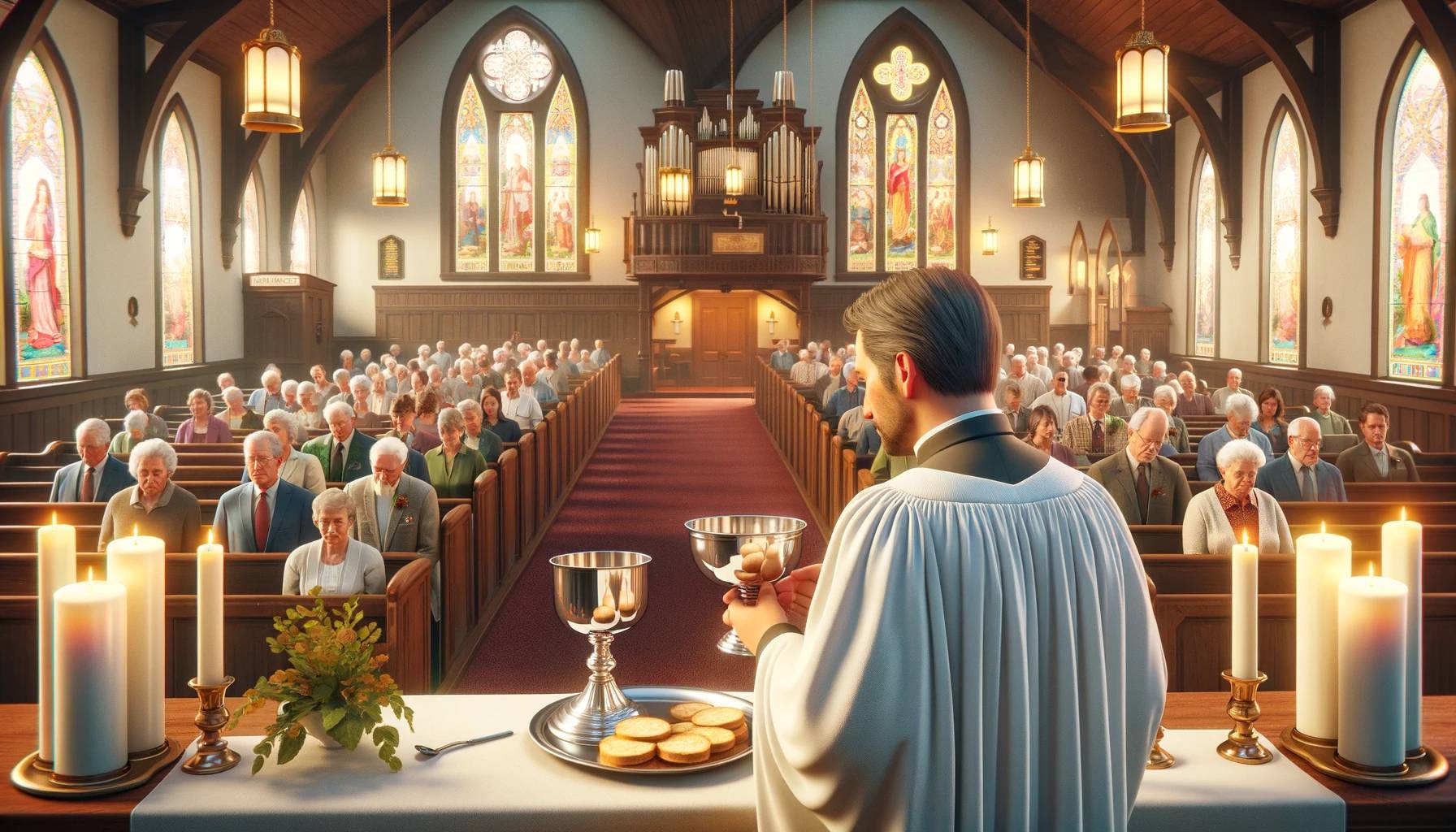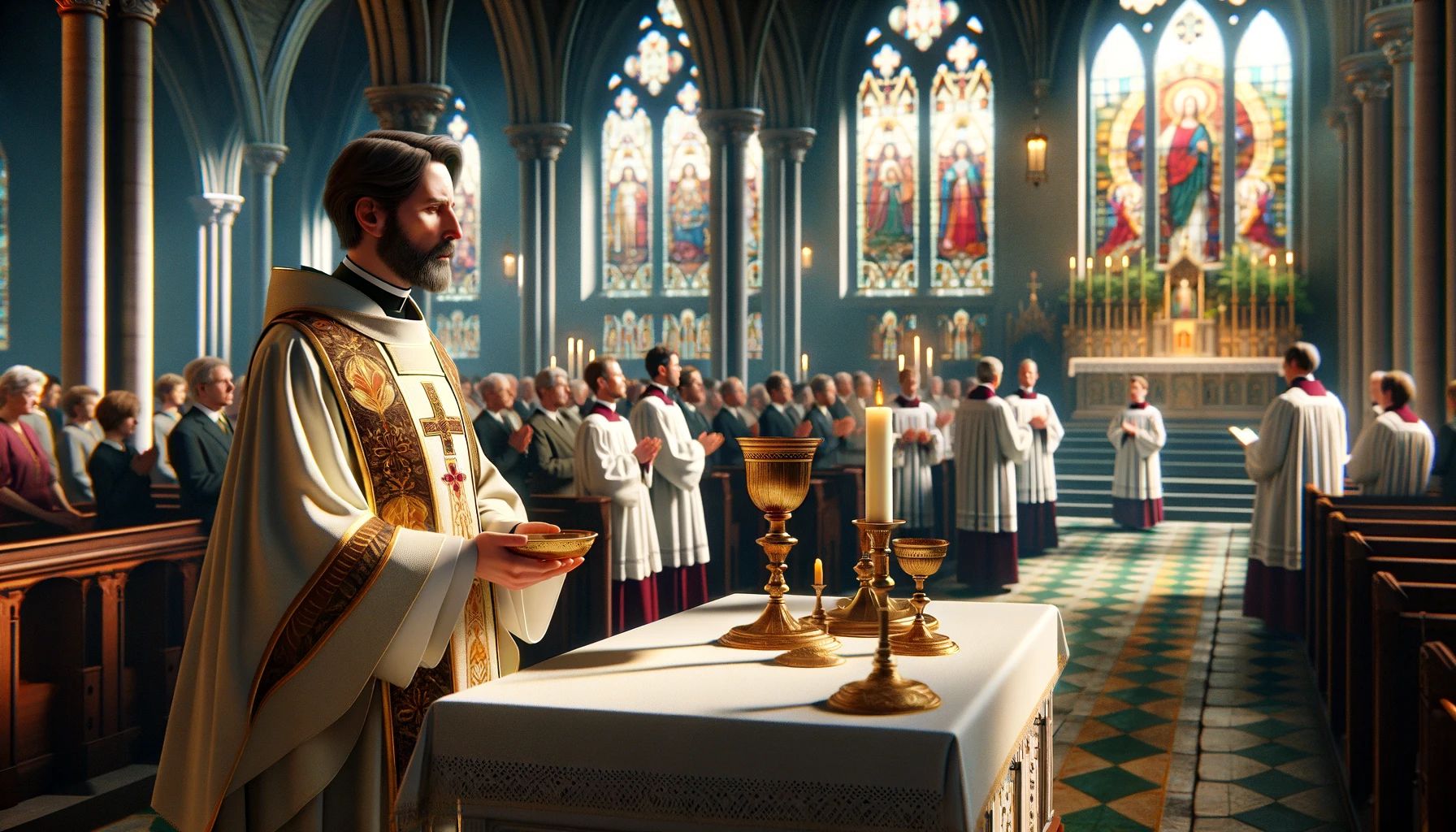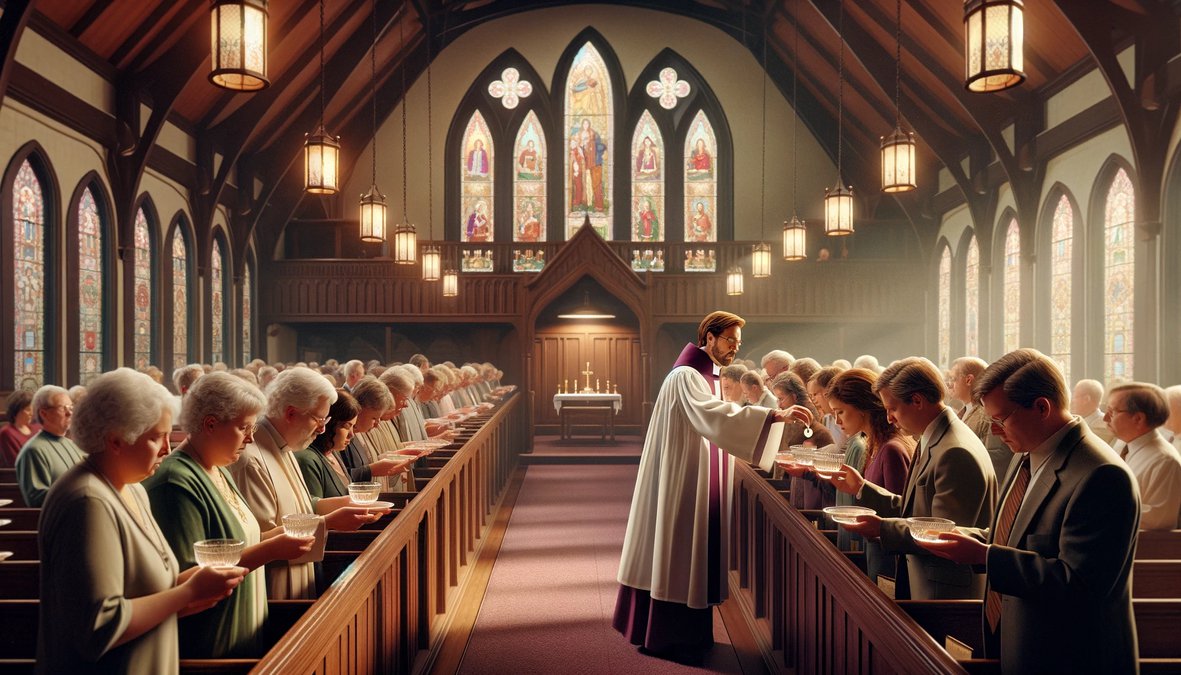Home>Theology and Spirituality>How To Prepare The Communion Table At A Baptist Church


Theology and Spirituality
How To Prepare The Communion Table At A Baptist Church
Published: February 25, 2024
Ericka Andersen, an editor at Christian.net, expertly merges digital strategy with content creation, focusing on faith and societal issues. Her communication skills enhance the platform's engaging narratives, fostering meaningful dialogue on belief's impact on society.
Learn the proper way to set up the communion table at a Baptist church with our comprehensive guide. Explore the theological significance and spiritual preparation involved. Ideal for those interested in theology and spirituality.
(Many of the links in this article redirect to a specific reviewed product. Your purchase of these products through affiliate links helps to generate commission for Christian.net, at no extra cost. Learn more)
Table of Contents
Introduction
The communion table holds a sacred place in the heart of Baptist churches, symbolizing the central message of the Christian faith – the sacrificial death and resurrection of Jesus Christ. As a focal point of worship, the communion table serves as a tangible reminder of the ultimate act of love and redemption. Its preparation and presentation are steeped in tradition and reverence, embodying the spiritual significance of the communion service.
In this comprehensive guide, we will delve into the meticulous process of preparing the communion table at a Baptist church. From understanding the profound symbolism behind the elements to the practical aspects of setting up and conducting the communion service, every step is infused with deep spiritual meaning and reverence.
The communion table stands as a visual representation of the Last Supper, where Jesus shared bread and wine with his disciples, instructing them to partake in remembrance of him. This act of communion, or sharing in the Lord's Supper, has been faithfully observed by Christians for centuries, embodying the spiritual connection with Christ and fellow believers.
As we embark on this journey of understanding and preparation, it is essential to approach the communion table with a heart full of reverence and humility. The process of setting the table is not merely a ritualistic practice but a profound act of worship, inviting participants to reflect on the sacrificial love of Christ and the unity of the body of believers.
With this in mind, let us explore the intricate details of preparing the communion table, from gathering the necessary elements to conducting the service with utmost reverence and devotion. As we delve into each aspect, may we gain a deeper appreciation for the spiritual significance of the communion table and the profound impact it holds within the Baptist tradition.
Read more: How To Prepare For First Holy Communion
Understanding the significance of the communion table in Baptist churches
The communion table, also known as the Lord's Table or the Eucharist, holds profound significance within Baptist churches, serving as a focal point of worship and spiritual reflection. At the core of its symbolism lies the remembrance of Jesus Christ's sacrificial death and resurrection, embodying the central message of redemption and spiritual unity.
In Baptist theology, the communion table represents a sacred space where believers gather to partake in the Lord's Supper, following the example set by Jesus during the Last Supper with his disciples. This act of communion is not merely a symbolic ritual but a deeply spiritual practice that fosters a profound connection with Christ and fellow believers.
The elements placed on the communion table – typically unleavened bread and wine or grape juice – carry rich symbolism. The bread symbolizes the body of Christ, broken for the redemption of humanity, while the wine or grape juice represents the blood shed for the forgiveness of sins. These elements serve as tangible reminders of Christ's ultimate sacrifice and the spiritual nourishment offered to believers through his atoning work.
Furthermore, the communion table embodies the Baptist belief in the priesthood of all believers, emphasizing the direct access to God through Christ without the need for intermediary clergy. This egalitarian approach underscores the communal nature of the Lord's Supper, where all participants, regardless of social status or background, come together as equal recipients of God's grace and love.
The act of partaking in communion at the table signifies a spiritual union with Christ and fellow believers, transcending denominational boundaries and emphasizing the universal body of Christ. It serves as a poignant reminder of the unity and fellowship shared among believers, reflecting the Baptist principle of congregational autonomy and the interconnectedness of the global Christian community.
In essence, the communion table in Baptist churches stands as a powerful symbol of Christ's redemptive work, the spiritual unity of believers, and the communal expression of faith. Its significance extends beyond a mere religious ritual, inviting participants to engage in a deeply transformative act of remembrance, gratitude, and spiritual communion with the living Christ and the global body of believers.
Gathering the necessary elements for the communion table
The process of gathering the necessary elements for the communion table is imbued with profound significance, as each item symbolizes the spiritual essence of the Lord's Supper within the Baptist tradition. The meticulous selection and preparation of these elements reflect the reverence and solemnity with which the communion service is approached.
1. Unleavened Bread
The first essential element is unleavened bread, symbolizing the body of Christ. In Baptist churches, the use of unleavened bread underscores the purity and wholeness of Christ, free from any impurity or sin. The bread is typically prepared in a manner that ensures its simplicity and lack of leavening agents, adhering to the biblical precedent set during the Last Supper.
2. Wine or Grape Juice
The second crucial element is wine or grape juice, representing the blood of Christ shed for the forgiveness of sins. In many Baptist churches, grape juice is used instead of wine to accommodate individuals who abstain from alcohol. The selection of wine or grape juice underscores the atoning sacrifice of Christ and the spiritual nourishment offered to believers through his redemptive work.
Read more: How To Serve Communion In The Baptist Church
3. Communion Vessels
The vessels used to hold the bread and wine are carefully chosen to reflect the solemnity of the occasion. Commonly, a chalice or small cups are employed to contain the wine or grape juice, signifying the precious nature of Christ's sacrifice and the spiritual sustenance received through communion. The selection of these vessels is marked by a sense of reverence and care, emphasizing the sacred nature of the elements they hold.
4. Linens and Coverings
The communion table is adorned with linens and coverings, signifying purity and sanctity. The use of white linens reflects the spiritual purity and holiness associated with the communion service. These coverings are meticulously arranged, underscoring the solemnity and reverence with which the communion table is prepared.
5. Additional Preparations
In addition to the core elements, other preparations may include the arrangement of candles, symbolic decorations, and the placement of a cross or other religious symbols near the communion table. These additional elements serve to enhance the spiritual ambiance and visual symbolism, creating a sacred space for the communion service.
The gathering of these essential elements is not merely a practical task but a deeply spiritual endeavor, embodying the reverence and significance attributed to the communion table within the Baptist tradition. Each item is carefully selected and prepared to honor the profound spiritual symbolism of the Lord's Supper, creating a sacred and reverent atmosphere for the communion service.
Setting up the communion table
Setting up the communion table is a meticulous and reverent process that embodies the spiritual significance of the Lord's Supper within Baptist churches. Every aspect of the preparation is infused with deep symbolism and care, creating a sacred space for the communion service.
Read more: How To Prepare For Lent
1. Arranging the Elements
The first step in setting up the communion table involves arranging the elements with utmost reverence. The unleavened bread, symbolizing the body of Christ, is placed on a plate or paten, signifying the wholeness and purity of Christ's sacrifice. The wine or grape juice, representing the blood of Christ, is carefully poured into the communion vessels, emphasizing the precious nature of Christ's atoning work.
2. Positioning the Elements
The positioning of the elements on the communion table is deliberate and symbolic. The bread and wine are placed at the center of the table, signifying their central role in the communion service. This placement underscores the focal significance of Christ's sacrifice and the spiritual nourishment offered to believers through communion.
3. Adorning the Table
The communion table is adorned with white linens and coverings, symbolizing purity and holiness. The use of white linens reflects the spiritual purity associated with the communion service, creating a visually striking representation of the sacred nature of the elements. Additionally, the careful arrangement of candles and symbolic decorations enhances the reverent ambiance, elevating the spiritual significance of the communion table.
4. Creating a Sacred Atmosphere
The overall setup of the communion table is aimed at creating a sacred atmosphere conducive to reflection and reverence. The placement of a cross or religious symbols near the table serves as a visual reminder of Christ's sacrifice and the central focus of the communion service. The lighting and ambiance further contribute to the creation of a sacred space, inviting participants to engage in deep spiritual contemplation.
5. Final Preparations
Before the commencement of the communion service, a final inspection and adjustment of the communion table are conducted to ensure that every element is in its rightful place. This meticulous attention to detail underscores the reverence and care with which the communion table is prepared, emphasizing the spiritual significance attributed to the Lord's Supper within the Baptist tradition.
The meticulous process of setting up the communion table is a profound act of reverence and devotion, embodying the spiritual significance of the communion service. Every element and arrangement serves as a tangible expression of the profound symbolism and spiritual depth inherent in the act of communion, creating a sacred space for believers to partake in the remembrance of Christ's sacrifice and the unity of the body of believers.
Conducting the communion service
The communion service in a Baptist church is a deeply reverent and spiritually significant occasion, embodying the central message of Christ's sacrificial love and the unity of believers. The process of conducting the communion service is marked by solemnity, reverence, and a deep sense of spiritual communion with Christ and fellow believers.
1. Invocation and Scripture Reading
The communion service typically commences with an invocation, a prayer that sets the tone for the sacred gathering. This prayer often emphasizes the significance of the Lord's Supper and invites participants to approach the communion table with hearts of gratitude and humility. Following the invocation, a relevant passage from the Scriptures, often from the Gospels or the writings of the apostle Paul, is read to provide biblical context and spiritual reflection on the significance of the communion service.
2. Exhortation and Reflection
A period of exhortation and reflection follows the Scripture reading, during which the minister or officiating individual offers spiritual insights and reflections on the meaning of the communion service. This segment serves as an opportunity for participants to engage in deep introspection, contemplating the sacrificial love of Christ and the spiritual unity shared among believers. The exhortation emphasizes the transformative nature of the communion service, inviting participants to partake with hearts full of reverence and gratitude.
Read more: How To Prepare For Baptism
3. Distribution of the Elements
The distribution of the elements – the unleavened bread and wine or grape juice – is a central aspect of the communion service. Participants are invited to approach the communion table reverently, often in an orderly manner, to receive the elements. The minister or designated individuals distribute the bread and wine, accompanied by solemn words emphasizing the significance of Christ's sacrifice and the spiritual nourishment offered through communion. This act of partaking in the elements symbolizes the spiritual union with Christ and fellow believers, fostering a profound sense of communal worship and reflection.
4. Prayer and Communion
Following the distribution of the elements, a period of prayer and communion ensues, allowing participants to partake in the bread and wine or grape juice. This segment is marked by a collective spirit of reverence and spiritual communion, as participants engage in personal prayer and reflection while partaking in the elements. The prayers offered during this time often center on gratitude for Christ's sacrifice, the forgiveness of sins, and the unity of the body of believers. The communion service culminates in a collective expression of faith and spiritual communion, underscoring the transformative and unifying power of the Lord's Supper.
5. Benediction
The communion service concludes with a benediction, a blessing pronounced by the minister, affirming the spiritual significance of the gathering and invoking God's grace and peace upon the participants as they depart. The benediction serves as a poignant reminder of the spiritual nourishment and unity experienced through the communion service, sending forth participants with a sense of spiritual renewal and communal fellowship.
The communion service in a Baptist church is a profound act of worship, inviting participants to engage in deep spiritual communion with Christ and fellow believers. Its reverent and reflective nature underscores the transformative power of Christ's sacrifice and the unity of the body of believers, creating a sacred space for remembrance, gratitude, and spiritual nourishment.
Conclusion
In conclusion, the preparation and presentation of the communion table at a Baptist church encompass a deeply spiritual and reverent process, embodying the profound significance of the Lord's Supper within the Baptist tradition. From the meticulous gathering of essential elements to the deliberate setting up and the conduct of the communion service, every step reflects the spiritual depth and transformative power of this sacred act of worship.
The communion table stands as a tangible representation of Christ's sacrificial love and the spiritual unity shared among believers. Its symbolism extends beyond mere ritualistic practice, inviting participants to engage in a profound act of remembrance, gratitude, and spiritual communion with the living Christ and the global body of believers. The communion service serves as a poignant reminder of the central message of redemption and spiritual unity, fostering a deep sense of reverence and communal fellowship.
As the elements are carefully arranged and the table is adorned with symbols of purity and holiness, the communion table becomes a sacred space for reflection and spiritual communion. The deliberate positioning of the elements and the ambiance created through prayers, exhortations, and reflections contribute to the creation of a reverent atmosphere, inviting participants to partake in the remembrance of Christ's sacrifice with hearts full of reverence and gratitude.
The communion service itself is marked by solemnity and spiritual communion, as participants engage in personal prayer and reflection while partaking in the elements. The act of communion symbolizes the spiritual union with Christ and fellow believers, transcending denominational boundaries and emphasizing the universal body of Christ. The service concludes with a benediction, affirming the spiritual significance of the gathering and invoking God's grace and peace upon the participants as they depart.
In essence, the communion table at a Baptist church serves as a powerful symbol of Christ's redemptive work, the spiritual unity of believers, and the communal expression of faith. Its preparation and presentation are not merely ceremonial but a deeply spiritual endeavor, inviting participants to engage in a transformative act of worship and reflection. The communion table stands as a testament to the enduring significance of the Lord's Supper, fostering a deep sense of reverence, gratitude, and spiritual nourishment within the Baptist tradition.











